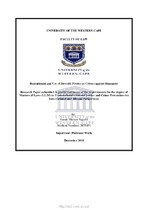| dc.description.abstract | Piracy attacks off the coast of the Horn of Africa have been on the rise in the recent years. According to a report by Ocean without Borders, although no vessels were hijacked by pirates off the coast of Somalia in 2017, 8 seafarers who were captured in 2016 were still being held in captivity. So far, 545 seafarers have been subjected to piracy attacks.1 The west coast of Africa has also experienced its fair share of piracy attacks. There has been an increase in piracy attacks off the coast of West Africa, two thirds of these attacks occurred off the coast of Nigeria.2The law governing maritime piracy is founded in the United Nations Convention on the law of the sea (UNCLOS).3Article 101 of the Convention defines piracy as; (a) any illegal acts of violence or detention, or any act of depredation, committed for private ends by the crew or the passengers of a private ship or a private aircraft, and directed:
i. on the high seas, against another ship or aircraft, or against persons or property on board such ship or aircraft;
ii. against a ship, aircraft, persons or property in a place outside the jurisdiction of any State;
(b) any act of voluntary participation in the operation of a ship or of an aircraft with knowledge of facts making it a pirate ship or aircraft; (c) any act of inciting or of intentionally facilitating an act described in subparagraph (a) or (b).
In addition to the UNCLOS, the Convention for the Suppression of Unlawful acts of Violence against the Safety of Maritime Navigation (herein after referred to as SUA Convention) also criminalises acts related to maritime piracy but which hinder the safe navigation of ships.4 The determining factor for crimes under the SUA Convention is whether the offence is a threat to the safe navigation or is likely to endanger the safe navigation of ships.5 The SUA Convention, however, differs from the UNCLOS in several aspects. First, the Convention does not require that the offence be committed for private ends. Second, the two ships requirement under Article 101 (a) of the UNCLOS is not applicable in the SUA Convention. The offences created in Article 3 of the SUA Convention imply that they may be committed by a perpetrator who is in the same ship with the victim. The SUA Convention does not provide for application of the principle of universal jurisdiction, a State can only exercise jurisdiction over the crimes if it is a party to it.6 Both the SUA Convention7 and the UNCLOS8 provide that the offence must be committed outside a State’s territorial waters. Article 4 of the SUA Convention however further limits the application of the Convention. The Convention does not apply to instances where the ship was not scheduled to navigate out of the territorial waters of the State. This limitation is not applicable under the UNCLOS. | en_US |

